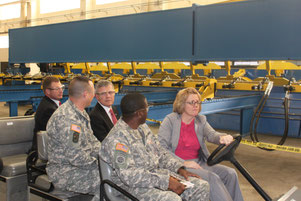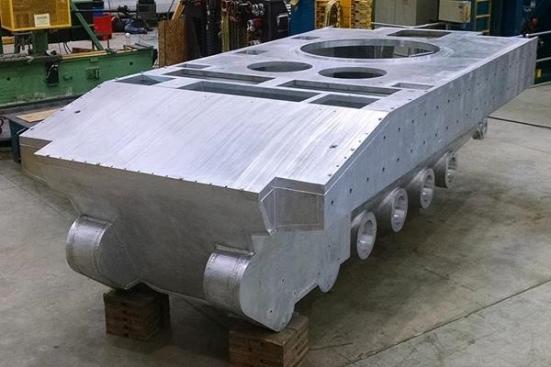Friction Stir Welding of Aluminium Armoured Plate
The U.S. Army Research Laboratory, known as ARL, is one of seven organizations that make up the U.S. Army Research, Development and Engineering Command. It is based on the Aberdeen Proving Ground, Maryland, and evaluated in 2013 the quality of friction stir welds independently to ensure that Army requirements are met regarding ballistic protection level, corrosion resistance and weldability.
The military specifications contain minimum acceptance values for ballistics, mechanical and chemical properties for different plate thicknesses of armour-plates. The analysis has resulted in a significant protective benefit as aluminium alloy AA 7017 has demonstrated a reduction in spallation compared with the legacy AA7039. An armor plate must not only arrest the projectile, but mitigate the kinetic energy before it fatally compromises a protected asset.[1]
The Army Materiel Command's top civilian John B. Nerger, Executive Deputy to the Commanding General of the Army Material Command, was shown the FSW machine at the Rock Island Arsenal Joint Manufacturing and Technology Center on 14 December 2012.[2]
© US Army
RIA-JMTC Commander, Col. James O. Fly, demonstrates the flatness of FSWed plates to the Department of Army Inspector General, Lt. Gen. Peter M. Vangjel, during a visit to the Rock Island Arsenal Joint Manufacturing and Technology Center on 31 January 2013.[3]
© US Army
OSD funds are used to test and evaluate mature technologies or products that the U.S. Army wants to procure. Since 1980, the mission of the U.S. Army Foreign Comparative Testing Program (FCT) has been to find and evaluate "here and now" solutions to meet operational needs regardless of the origin of that technology.
When a projectile strikes the front of the plate, it sends a compressive wave through the plate. The compressive wave hits the back surface of the plate and it reflects as a tensile wave. If the tensile stresses developed by the wave are higher than the tensile strength of the material, a large piece of a material, bigger than the caliber of the projectile, breaks off. Even though the projectile stopped in the plate, a piece of material with residual energy capable of causing damage flies off the back in a process called spalling or spallation.
The weldability of aluminium alloys is vital for achieving the ballistic performance of lightweight military vehicles, because many of the features of an alloy's chemistry and heat treatment that lead to improved strength and ballistic protection typically degrade the weldability. The friction stir welds experience severe stresses that are magnified during a ballistic impact or blast event and need to handle much more than welds do in the everyday world.
The aluminum alloys validated by ARL can be applied to all types of vehicles, depending on the actual needs. These include mine-resistant ambush-protected vehicles, commonly known as MRAPs, Humvees, and lightweight armored vehicles such as personnel carriers and the Bradley Fighting Vehicle.[1]
FSW Machines for Military Tanks
A state-of-the-art friction stir welding machine was installed at Rock Island in 2012, to be used for military applications in collaboration with H.F. Webster.[3]
The U.S. Army and General Dynamics Land Systems installed a large gantry style FSW machine at their Joint Systems Manufacturing Facility (JSMC) in Lima, Ohio, to fabricate military vehicle demonstration structures of aluminum, which were designed with multiple butt and corner joint weld geometries. The experimental work focused on developing production-level, single-pass FSW parameters for thicknesses ranging from 12.7 to 40.6 mm (0.5-1.6 inches) in aluminum alloys 5083, 5059 and 2139.[4]
President Donald Trump inspects innovative military vehicles at JSMC in Lima, Ohio
Friction Stir Welded Hull Prototype Designed by the Ground Vehicle Systems Center and Fabricated by Concurrent Technologies Corporation[8][9][10]
© U.S. Army Combat Capabilities Development Command (CCDC) Ground Vehicle Systems Center (GVSC)
Concurrent Technologies Corp. (CTC) has received a contract on making and testing a “Friction Stir Welded Hull Manufacturing Prototype” and will collaborate from September 2017 to September 2022 with the U.S. Army Tank Automotive Research, Development and Engineering Center (TARDEC), Warren, Michigan on conducting fatigue, ballistic, and other qualification tests on friction stir welds. CTC has a bespoke friction stir welding machine that provides 8 m (26 feet) in the longitudinal x-direction and 4 m (13 feet) in the vertical z-direction. It can weld high-strength 2000-series aluminum plate, up to 82.5 mm (3¼-inches) thick, in a single pass.[5][6][7]
References
- Dan Lafontaine (U.S. Army Research, Development and Engineering Command): Armor plates' ballistics protection scrutinized for Soldier
safety. 5 December 2013.
- Rhys Fullerlove (AMC): AMC top civilian sees new technology at Rock Island Arsenal-JMTC. 14 December 2012.
- Rhys Fullerlove (AMC): Department of Army Inspector General sees new technology at Rock Island
Arsenal-JMTC. 31 January 2013.
- Brian Thompson, Mike Eff, Tim Stotler, Zak Pramann, John Seaman, Roger Spencer, Perry White (all EWI), Kevin Doherty (Weapons and Materials Research Directorate, ARL) and Craig Niese (General
Dynamics Land Systems): Friction Stir Welding of Thick Section Aluminum
for Military Vehicle Applications. Army Research Laboratory Aberdeen Proving Ground, MD 21005-5069 ARL-RP-417 December 2012.
- Dylan Malyasov: U.S. Army mysterious combat vehicle spotted during shipping to Alaska. 10-15
November 2019.
- Victor Burguess: Investigating Friction Stir Welding in Aluminum Hull Structures. DSIAC Journal,
Summer 2019, Volume 6, Number 3.
- Mike Mc Call, Joe Pickens and Jamie Florence: Friction stir welding - an innovative
commercial joining method revolutionizing the design, fabrication and performance of Army Ground Vehicle Structures and Armors. 2005 CTMA Symposium.
- Victor Burguess: Investigating Friction Stir Welding in Aluminum Hull Structures. 2
November 2019.
- Victor Burguess: Investigation in Friction Stir Welded Aluminum Alloy 2139-T8 for Hull Structure Applications, 2019.
- Concurrent Technologies Corporation Wins Competitively Bid Contract to Support the U.S. Army with Manufacturing of Ground Combat Vehicle Prototype Hulls.







